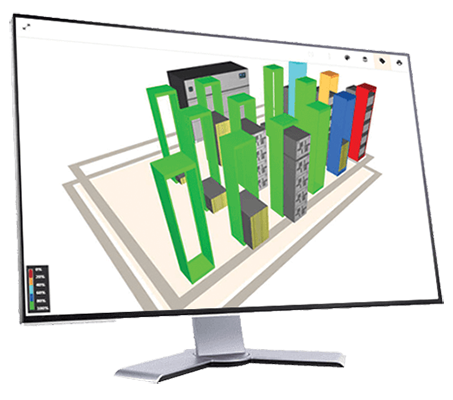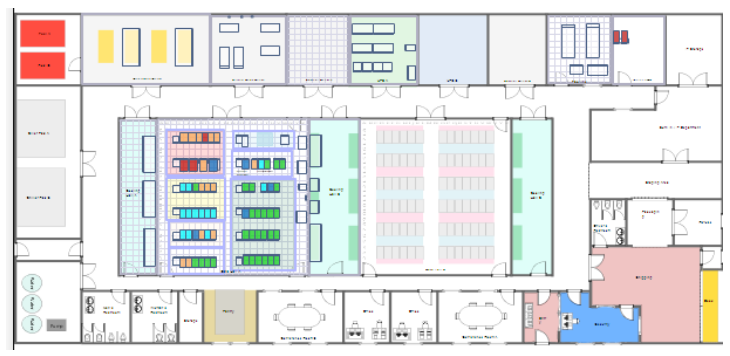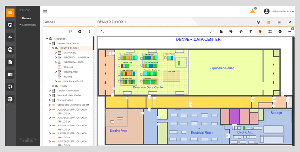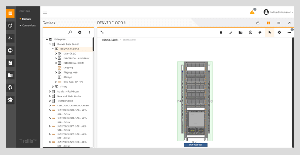
Vertiv Trellis Inventory Manager
The Ultimate Tool For Keeping Track of All of Your Assets

Click here to jump to more pricing!
Overview:
- Banking, Financial and Insurance
- Data Center/Colocation/Hosting
- Education
- Government
- Healthcare
- Manufacturing
- Military, Defense, Aerospace and Missile
- Retail and Wholesale
- Telecom
- Transportation
The Trellis Inventory Manager allows data center stakeholders to know exactly what assets, connections and capacity exist in their facility and easily make changes for optimal performance. It provides a set of graphical visualization tools to allow the infrastructure team to map out its floor space and understand where assets are, who they belong to and how they are connected.
Trellis Inventory Manager allows data center stakeholders to know exactly what physical or virtual assets, connections and capacity exist in their facility and easily make changes for optimal performance. It provides the ability to visualize physical and virtual inventory and show the physical capacities needed and available to support both. It removes the need for costly and unnecessary buffers and enables the facilities side to support all the virtual load it can handle. Trellis Inventory Manager provides a set of graphical visualization tools to allow the infrastructure team to map out its floor space and understand where assets are, who they belong to and how they are connected.
Users can collect a detailed catalog of all the inventory items that are placed in the data center as well as understand how much capacity (power, cooling, weight and space) is available and consumed at any point in the data center based on faceplate or de-rated values. View capacities in any floor/space, inside any elevation (e.g., rack) or inside the actual assets (e.g., blade chassis) with ease.
The Trellis Inventory Manager goes beyond inventory management and allows teams to intelligently plan projects and track changes made. It gives both IT and facilities teams a unified view of a project and the tasks assigned to each personnel to avoid errors due to lack of coordination. Project managers can visualize the state of the same rack in different periods of time through the rack timeline view. It is the perfect tool for implementing changes in the data center, from planning and execution down to auditing and reporting. Move inventory with ease and confidence, knowing capacity exists where assets are placed.
With Trellis Inventory Manager, there is no need for spreadsheets, Visio diagrams, physically searching the data center and endless meetings. Use it for better asset and project management.
Manage Assets and Connections Visually
- Know exactly what’s inside your data center so you can better manage and optimize your physical assets and virtual servers.
- Search and locate the full data center inventory without leaving your desk; use of symbolic library representation is like being physically present inside the data center.
- Select an asset and view all its properties, capacities, contained devices and connections to other devices.
- Create realistic floor plan models by importing AutoCAD plans and plotting the racks on the blueprint.
- View spaces and zones in an XY-tiled format to get a higher level of precision in pinpointing devices; rack elevation view shows the exact placement of all devices in your racks.
- Divide the data center floor plan based on functions by defining spaces, as well as zones within those spaces, so all users can quickly differentiate which areas are for production, staging and safety.
- Search devices using the software interface instead of roaming physically, reducing time spent by personnel inside the data center.
- Visualize the total capacity consumption via top-down view to show where you have capacity remaining and where you are nearing the limit.
- Show the power connections between any device port and its upstream or downstream devices; verify the status of all assets in the same power chain.
- Ensure a server’s power redundancy through power dependency monitoring—you’ll see if two different rack PDUs are connected to the selected device.
Implement Data Center Changes with Confidence
- Avoid “on-the-fly” decisions and reduce time for implementing data center projects.
- Conduct detailed impact analysis to determine e fect of planned change, lessen risks associated with it and avoid time-consuming rework.
- Plan out a complex set of steps involved in a project (such as server and rack moves, data connection changes, etc.) and then implement the change against a record of progress.
- Manage resource asset reservation(s) including rack space, power capacity and outlets.
- See the state of the same rack in different periods of time through the rack timeline view.
- Create standard data center processes and enforce policies with assignment and tracking of tasks.
- Reduce risks of unplanned downtime and other issues brought by lack of coordination by providing IT and facilities teams a unified view of projects.
- Fully comply with auditing requirements using a detailed record of changes made and the personnel accountable for specific tasks.
- Run customizable reports and export via CSV file.
- Build confidence among decision makers that planned changes are well-designed, well-documented, easy-to-follow and executed in a controlled manner.

Features and Benefits:
Benefits
- The Trellis Inventory Manager allows data center stakeholders to know exactly what assets, connections and capacity exist in their facility, and easily make changes for optimal performance. It provides a set of graphical visualization tools to allow the infrastructure team to map out its floor space and understand where assets are, who they belong to and how they are connected.
- Users can collect a detailed catalog of all the inventory items that are placed in the data center, as well as understand how much capacity (power, cooling, weight and space) is available and consumed at any point in the data center based on faceplate or de-rated values. View capacities in any floor/space, inside any elevation (e.g., rack) or inside the actual assets (e.g., blade chassis) with ease.
Features
- Minimize effort brought by manual, outdated or conflicting lists of data center assets
- Minimize errors due to outdated or conflicting lists of assets; you maintain only one comprehensive source of documentation for all devices in the data center
- Find equipment (and relevant asset data) quicker through the use of a search-and-locate feature
- Fast-track device placement, provisioning or decommissioning with help from a comprehensive and unified floor, rack plan and device plan
- Quickly determine what connections exist for a chosen asset (no more tracing cables behind racks)
- Reduce time spent and personnel traffic inside the data center
- Understand exactly what capacities exist within the data center, what has already been used and what is remaining, understanding how the consumption levels rate against thresholds that apply
Specifications:
Workstation Requirements
| Trellis Inventory Manager Specifications | |
|---|---|
| General Information | |
| Application | Inventory and Asset Management |
| Processor | Front Machine - Intel Xeon 2.6 GHz 8M L3 cache; Back Machine Intel Xeon 2.6 GHz 8M L3 cache |
| Server Operating System | Microsoft Windows Server 2012 R2; Red Hat Enterprise Linux version 6.7,6.10 or 7.3; CentOS 7.4 |
| Supported Browsers | Google Chrome version 63.0 and higher; Microsoft Edge 42.17134.1.0 and higher. |
| Version | 5.0.3 |
| CPU | |
| CPU Manufacturer | Intel Xeon |
| CPU count | Front and Back Machines: Small - 1; Medium - 2; Large - 2; Enterprise - 2 |
| CPU Cores | Front and Back Machines: Small - 4; Medium - 4; Large - 4; Enterprise - 8 |
| Memory (GB) | Front Machine: Small - 32; Medium - 32; Large - 40; Enterprise - 44 Back Machine: Small - 24; Medium - 32; Large - 32; Enterprise - 32 |
| Storage and Ethernet | |
| Storage | Front and Back Machines: 300GB Enterprise class |
| Ethernet | Front and Back Machines: >80 MB/s |
Hardware Recommendations
| Data Size Guidelines | Small | Medium | Large | Enterprise |
|---|---|---|---|---|
| Concurrent users | 10 | 20 | 50 | 100 |
| Devices | 2,000 | 20,000 | 100,000 | 200,000 |
| Power Connections | 1,000 | 10,000 | 60,000 | 100,000 |
| Data Connections | 2,000 | 10,000 | 60,000 | 100,000 |
| Monitored Datapoints | 1,000 | 10,000 | 40,000 | 140,000 |
| Front Machine | Small | Medium | Large | Enterprise |
| Processor | Intel Xeon 2.6 GHz 8M L3 cache | |||
| CPU count | 1 | 2 | 2 | 2 |
| CPU Cores | 4 | 4 | 4 | 8 |
| Memory (GB) DDR3 1333 MHz | 32 | 32 | 40 | 44 |
| Disk throughput | > 500 MB/s (sequential) [un-cached] | |||
| Storage | 300 GB Enterprise class | |||
| Ethernet | > 80 MB/s | |||
| Front Machine | Small | Medium | Large | Enterprise |
| Processor | Intel Xeon 2.6 GHz 8M L3 cache | |||
| CPU count | 1 | 2 | 2 | 2 |
| CPU Cores | 4 | 4 | 4 | 8 |
| Memory (GB) DDR3 1333 MHz | 24 | 32 | 32 | 32 |
| Disk throughput | > 500 MB/s (sequential) [noncached] | |||
| Storage | *300 GB Enterprise class for base installation | |||
| Ethernet | > 80 MB/s | |||
Documentation:
Download the Vertiv Trellis Inventory Manager Datasheet (.PDF)
Pricing Notes:
- Pricing and product availability subject to change without notice.


